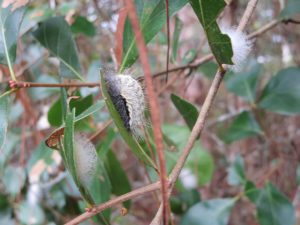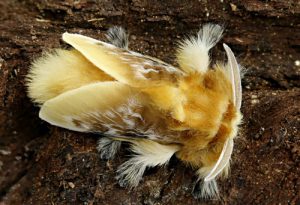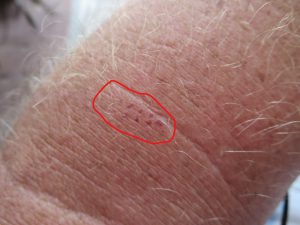
This summer my property has been bombarded by fuzzy teardrop-shaped caterpillars. This fiend is the “puss caterpillar.” It is the larva of the southern flannel moth (Megalopyge opercularis). The puss caterpillar is also known as Italian asp, possum bug, perrito, and my favorite, the woolly slug. (see entnemdept.ufl.edu).
This caterpillar is found on the east coast from New Jersey to Florida and westward to Arkansas and Texas. The coloration varies from gray white, golden brown to a dark gray. It often has an orange streak running longitudinally on the back, but this can be camouflaged by the long hairs.

Host plants for the puss caterpillar are many including oaks, elms, maples and ornamental landscape plants like roses and ivy. The caterpillars tend to skeletonize the leaves. Unfortunately, I am finding them widespread including grasses.
As eggs and early larvae, they are eaten by generalist predators which include lacewings, brachnid wasps and tachinid flies. As they age, they are protected by their toxin filled spines. Control of caterpillars can be attempted by the use of Bt (Bacillus thuringiensis) and chemical insecticides such as permethrin. Unfortunately, these control measures are not selective and will kill ALL types of caterpillars if they are present as well.
Puss caterpillars typically are not important from a vegetative standpoint but rather as a medical problem. They are one of the most venomous caterpillars in the United States. The puss caterpillar releases toxins via a venom gland at the base of the hollow spines as a defense mechanism when touched. The severity of the sting depends upon the thickness of the skin where it occurred. Localized symptoms include immediate intense burning, throbbing pain followed by a grid like pattern of red bumps on the skin matching the caterpillar spines.

Swelling and enlargement of regional lymph nodes can occur as well. People sensitive to the toxin could experience systemic symptoms such as headache, fever, nausea and vomiting, increased heart rate, low blood pressure, seizures and rarely muscle spasms, abdominal pain and convulsions. Immediate treatment after a sting may decrease the symptoms. Adhesive tape (Scotch tape) placed on the sting site initially may remove broken spines from the skin, followed by applying ice packs, oral antihistamines and topical hydrocortisone cream. Systemic symptoms may require a trip to the E.R. (Hossler, EW 2010 JAAD)
The message I want to convey to you is to avoid these caterpillars at all cost! Be aware your pets may become victims as well. Let’s hope the fall season is not as bad. Good Luck!
This article was contributed by Tina Roberts-Smith PA-C, a Master Gardener in Volusia County
Questions? Contact a Volusia County UF/IFAS Master Gardener:
Phone: (386) 822-5778, Monday-Friday, 8:30-4:30
Email: MasterGardener@volusia.org
 0
0
